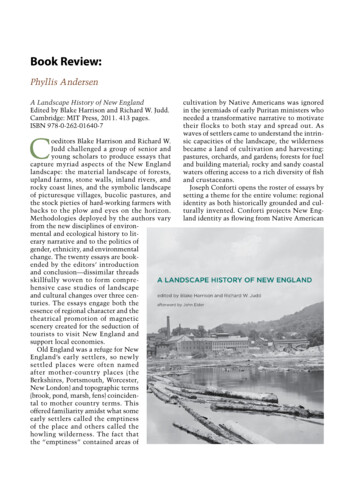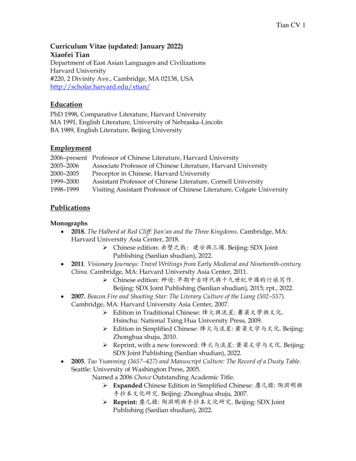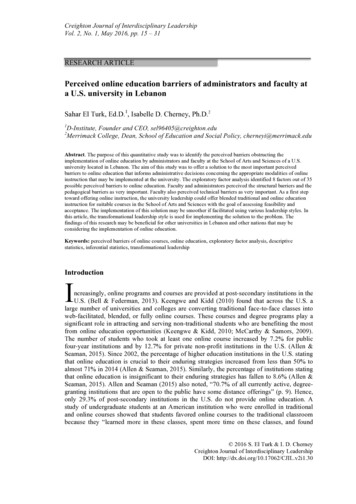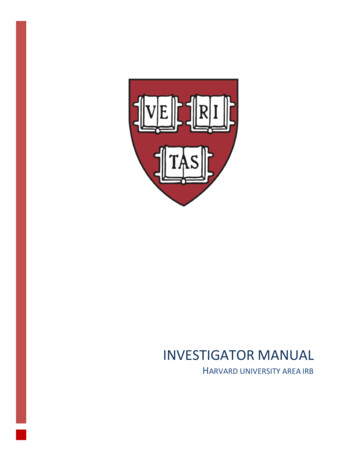
Transcription
Book Review:Phyllis AndersenA Landscape History of New EnglandEdited by Blake Harrison and Richard W. Judd.Cambridge: MIT Press, 2011. 413 pages.ISBN 978-0-262-01640-7Coeditors Blake Harrison and Richard W.Judd challenged a group of senior andyoung scholars to produce essays thatcapture myriad aspects of the New Englandlandscape: the material landscape of forests,upland farms, stone walls, inland rivers, androcky coast lines, and the symbolic landscapeof picturesque villages, bucolic pastures, andthe stock pieties of hard-working farmers withbacks to the plow and eyes on the horizon.Methodologies deployed by the authors varyfrom the new disciplines of environmental and ecological history to literary narrative and to the politics ofgender, ethnicity, and environmentalchange. The twenty essays are bookended by the editors’ introductionand conclusion—dissimilar threadsskillfully woven to form comprehensive case studies of landscapeand cultural changes over three centuries. The essays engage both theessence of regional character and thetheatrical promotion of magneticscenery created for the seduction oftourists to visit New England andsupport local economies.Old England was a refuge for NewEngland’s early settlers, so newlysettled places were often namedafter mother-country places (theBerkshires, Portsmouth, Worcester,New London) and topographic terms(brook, pond, marsh, fens) coincidental to mother country terms. Thisoffered familiarity amidst what someearly settlers called the emptinessof the place and others called thehowling wilderness. The fact thatthe “emptiness” contained areas ofcultivation by Native Americans was ignoredin the jeremiads of early Puritan ministers whoneeded a transformative narrative to motivatetheir flocks to both stay and spread out. Aswaves of settlers came to understand the intrinsic capacities of the landscape, the wildernessbecame a land of cultivation and harvesting:pastures, orchards, and gardens; forests for fueland building material; rocky and sandy coastalwaters offering access to a rich diversity of fishand crustaceans.Joseph Conforti opens the roster of essays bysetting a theme for the entire volume: regionalidentity as both historically grounded and culturally invented. Conforti projects New England identity as flowing from Native American
New Hampshire Historical Society30 Arnoldia 69/3 February 2012
T. W. Smillie, National Archives photo 22-CD-451A Landscape History of New England 31“Fishermen and weir, Passamaquoddy Bay region near Eastport, Maine, circa 1880. This photograph was part ofbroader study by the U.S. Fish Commission for the 1880 U.S. Census. It shows fishermen using a traditional brushweir to take herring for the burgeoning canning industry.”tribes such as the Algonquians, with their seasonal settlements and cultivation of crops, tothe formation of isolated towns and villages distributed across farmland and along the seacoast,a land-planning method still visible today.The New England landscape was physicallyreconstituted in the nineteenth century with asurge of industry, especially shoe manufacturing, textile mills, and ship building. The currentevolutionary stage of development includes atopology of leisure and recreation: heritagesites, boutique-lined waterfronts, ski slopes,athletic fields, and the indigenous clothier offishers and hunters, L. L. Bean. Conforti quotesDona Brown, a historian at the University ofVermont, to describe that tourist landscape as“a commodity peddled and consumed like thenotions of an itinerant Yankee trader.”In his essay, Kent Ryden finds the well-wornargument of nature vs. culture a useless bit ofrhetoric in understanding the New Englandlandscape. Everything we see is the result ofland use, he insists, recorded in the ways thathuman minds and hands worked in tandemwith natural opportunities and constraints. Hecites a little-known essay by Thoreau, “TheSuccession of Forest Trees,” first deliveredas a lecture in 1860. From years of observing“Tourists in Franconia Notch, 1920s. Franconia Notch was one of the most popular sites in New Hampshire’sWhite Mountains. Here, tourists by the shores of Profile Lake gaze upward at the Old Man of the Mountain.”Source: From Automobile Blue Book.
February 2012Library of Congress32 Arnoldia 69/3“Robert Havell, ‘View of the City of Boston from Dorchester Heights,’ circa 1841. Views of Boston Harbor like this one providean incomplete picture, because they show only the landscape visible to the human eye. Some of the harbor’s most indispenablefeatures, such as its ship channel and anchorage, were part of an underwater landscape that lay out of sight beneath the waves.”the transformation of abandoned farm fieldsback to forests, Thoreau became aware that thespecies mix of the New England forest in themid-nineteenth century was as much a resultof human interventions as natural succession.Ryden adds to Thoreau’s observation that NewEngland’s famous fall foliage is as much determined by human intervention as by naturalprocess. His evidence is that when first-growthforests were cleared for timber and farmlandby the middle of the nineteenth century, threequarters of the region had been deforested andthe fields derocked. With the diminishing ofagricultural use, the forests returned as oldfields were taken over by white pine (Pinus strobus), which thrives in sunlight and can survivein poor soils. As the pine forests matured, anunderstory of deciduous species, mainly oaksand maples, established themselves below theevergreen canopy. At the turn of the twentiethcentury, pines were cut for wood products andthe young deciduous species could then dominate, producing colorful autumn foliage thatwas of little value to farmers but was essentialto establishing the ritual of autumn visitors(leaf-peepers) to New England.Despite the difficulty of subsistence farmingin New England, by the early twentieth centurythe farm complex of pasture, cultivated fields,orchards, and picturesque barns and outbuildings offered symbolic value to visiting urbanites fatigued by lives over which they had little
A Landscape History of New England 33Special Collections, Raymond H. Fogler Library, University of Mainecontrol. Attracted to a life of self-sufficiency,writers in particular were drawn to the backcountry of New England where they documented their survival tactics in numerous publications. Dona Brown describes a little knownback-to-the-land movement of the 1930s; shenotes that an “imaginative reconfiguration”of New England was underway as the image ofa region full of “dour puritans and antiquatedblue laws” was refigured.In a 1932 editorial in Harper’s Monthly, thenoted writer and historian Bernard DeVotoobserved that the Great Depression was notas severe in New England because long yearsof trials and tribulations had given the peoplegreat moral strength: “By the granite they havelived for three centuries, tightening their belts“Henry Red Eagle on the shores of Moosehead Lake, circa1940. Red Eagle often drew inspiration from the MooseheadLake region, incorporating its recreational and its workingspaces into his writing.” Source: From Bangor & AroostockRailroad, In the Maine Woods (1941).and hanging on.” Brown uses as an examplethe writer Elliott Merrick and his wife whogave up urban life for a back country farm inVermont where Merrick wrote From This HillLook Down (1934). He stressed self-reliance andhard work in taming nature as a way to revitalize the urbanized mind and body. The couplewas followed by another pair of writers, Helenand Scott Nearing, who relocated first to ruralVermont and then Maine. Their book, Livingthe Good Life (1954), became a manual for disaffected youth of the 1960s and 1970s.Elizabeth Pillsbury investigates Long IslandSound on New England’s southerly shore, valued first for its oysters and later for boating recreation. The Sound became a waste depositoryand ended up as a dead ecosystem. Moving upthe coast line, Robert Gee brings his reader toMaine’s “drowned coast” created by the risingand then receding sea level revealing land features: dramatic inlets of eroded tide pools andisland clusters accommodating a rich varietyof sea and shorebird life. Gee tracks the development of Maine’s fish canning and blueberryindustries in tandem with its growing popularity for tourists and summer homes. Movingback down to Boston, Michael Rawson tracesthe concern for the environmental health ofBoston Harbor today back into the nineteenthcentury, when extensive filling of brackish tidalflats dramatically altered the shore line.The topic of alternative ways of writing aboutthe New England landscape is covered by twoessays on lesser known individuals, each dealingwith the ambiguity between documentary andfantasy writings. Under the pen name HenryRed Eagle, the Native American writer and wilderness guide, Henry Perley, wrote numerousstories about Maine’s north woods. Written fora popular audience, his tales of adventure andromance highlighted his Native culture. Perleyalso participated in tourist activities, and likemany other Natives took roles in national performing troupes such as P. T. Barnum’s, cooperating with displays of stereotypical Indianbehavior demanded as entertainment by “whiteman” audiences. Similarly, the Maine travelwriter George H. Haynes, who, in the wordsof contributing author David L. Richards, spe-
34 Arnoldia 69/3 February 2012cialized in the two social dimensions of landscape in general: timeless antiquity and rushingmodernity; he blended literary romanticismwith journalistic realism that he referred to as“a bit of realistic fairy-land” writing. Haynesprodigious output included books, articles,historic treatment of scenic areas, and promotional brochures.Across New England, tourism filled the gapwhen the utility of lumber and crop-producing landscapes moved on. The landscape thathad made agriculture so difficult on rockyupland pastures changed in people’s minds toa topography of gentle mountains and valleyscut through by rivers and streams—romanticscenery documented by artists, photographers,and souvenir postcards. Tourism also respondedto picturesque scenes of villages with whitepainted houses, church spires, and town greens.John Cumbler describes how the landscapeof Cape Cod, described by Thoreau as the“bared and bended arm of Massachusetts,”evolved from the productive but fragile landscape of fisheries, salt works, and grain fieldsto pleasure grounds for summer visitors. Thesandy and nutrient- poor soil and overgrazingby sheep and cattle led to depopulation of thearea by the turn of the century, while tourismgrew from early guest houses and cottage communities to golf courses and seaside hotels onmanicured lawns.The editors admit that more work needs tobe done on the urban landscape of New England. Two useful articles in this volume take upthe urban story in the late nineteenth century.Phil Birge-Liberman reveals that the Bostonpark system was created as much by the valuesof the reigning Yankee upper class as it wasto satisfy a genuine need for leisure spaces onbehalf of the city’s burgeoning population. Theannexation of neighboring towns to the city ofBoston and the growing number of immigrantscompelled the Yankee leaders to do a bit ofsocial engineering by developing a park systemthat could control behavior and ease social tensions. Birge also treats real estate speculationand its link to park development—an area thatneeds much more investigation not only in Boston but other American cities. James O’Connellexamines the Boston metropolitan landscape inthe twentieth century: the linkage of suburbs,highway development, and a regenerative wayof life in expanded urban areas.European academics use the idea of terroir,a French term based on terre (land as place),referring to an area where soil and microclimateconditions produce distinctive qualities in foodproducts, especially wine. An expanded definition of terroir includes the customs and traditions of a people. A closer reading of the NewEngland landscape that integrates the work ofearth scientists is in the future of environmental history. It would serve to deepen and enrichthe current discourse that continues to takemuch for granted. This book offers a distinctivebase for this dialogue to continue.Additional Reading(books by some of the essay authors)Brown, Dona. Inventing New England: Regional Tourismin the Nineteenth Century. Washington D.C.:Smithsonian Institution Press, 1995.Conforti, Joseph A. Imaging New England: Explorationsof Regional Identity from the Pilgrims to theTwentieth Century. Chapel Hill: University ofNorth Carolina Press, 2001.Cumbler, John T. Reasonable Use: the People, theEnvironment and the State, New England1790–1930. New York: Oxford UniversityPress, 2001.Harrison, Blake. The View from Vermont: Tourism andthe Making of an American Rural Landscape.Hanover, N.H.: University Press of NewEngland, 2006.Judd, Richard W. Common Lands, Common People:The Origins of Conservation in Northern NewEngland. Cambridge: Harvard UniversityPress, 1997.O’Connell, James. Becoming Cape Cod: Creating aSeaside Resort. Lebanon, N.H.: University Pressof New England, 2003.Rawson, Michael. Eden on the Charles: The Making ofBoston. Cambridge: Harvard University Press,2010.Ryden, Kent C. Landscape with Figures: Nature andCulture in New England. Iowa City: Universityof Iowa Press, 2001.Wood, Joseph S. The New England Village. Baltimore:Johns Hopkins University Press, 1997.Phyllis Andersen is a landscape historian and formerdirector of the Institute for Cultural Landscape Studiesof the Arnold Arboretum.
Book Review: Phyllis Andersen A Landscape History of New England Edited by Blake Harrison and Richard W. Judd. Cambridge: MIT Press, 2011. 413 pages. ISBN 978-0-262-01640-7 C oeditors Blake Harrison and Richard W. Judd challenged a group of senior and young scholars to produce essay











